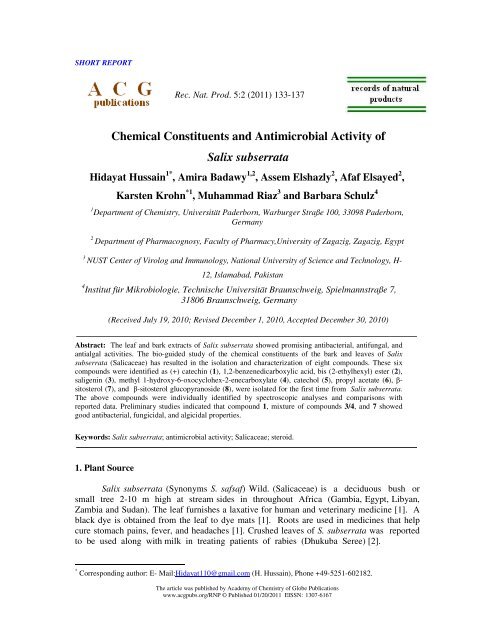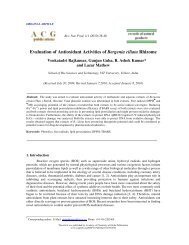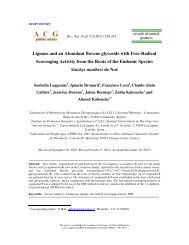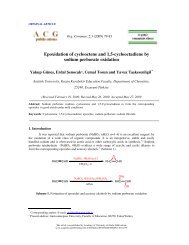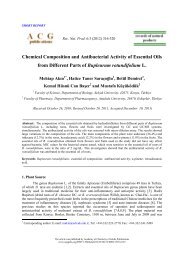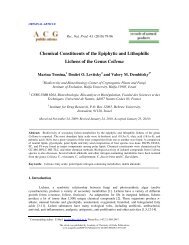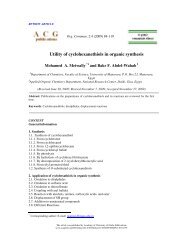Chemical Constituents and Antimicrobial Activity of Salix subserrata
Chemical Constituents and Antimicrobial Activity of Salix subserrata
Chemical Constituents and Antimicrobial Activity of Salix subserrata
Create successful ePaper yourself
Turn your PDF publications into a flip-book with our unique Google optimized e-Paper software.
SHORT REPORT<br />
Rec. Nat. Prod. 5:2 (2011) 133-137<br />
<strong>Chemical</strong> <strong>Constituents</strong> <strong>and</strong> <strong>Antimicrobial</strong> <strong>Activity</strong> <strong>of</strong><br />
<strong>Salix</strong> <strong>subserrata</strong><br />
Hidayat Hussain 1* , Amira Badawy 1,2 , Assem Elshazly 2 , Afaf Elsayed 2 ,<br />
Karsten Krohn *1 , Muhammad Riaz 3 <strong>and</strong> Barbara Schulz 4<br />
1 Department <strong>of</strong> Chemistry, Universität Paderborn, Warburger Straße 100, 33098 Paderborn,<br />
Germany<br />
2 Department <strong>of</strong> Pharmacognosy, Faculty <strong>of</strong> Pharmacy,University <strong>of</strong> Zagazig, Zagazig, Egypt<br />
3 NUST Center <strong>of</strong> Virolog <strong>and</strong> Immunology, National University <strong>of</strong> Science <strong>and</strong> Technology, H-<br />
12, Islamabad, Pakistan<br />
4 Institut für Mikrobiologie, Technische Universität Braunschweig, Spielmannstraße 7,<br />
31806 Braunschweig, Germany<br />
(Received July 19, 2010; Revised December 1, 2010, Accepted December 30, 2010)<br />
Abstract: The leaf <strong>and</strong> bark extracts <strong>of</strong> <strong>Salix</strong> <strong>subserrata</strong> showed promising antibacterial, antifungal, <strong>and</strong><br />
antialgal activities. The bio-guided study <strong>of</strong> the chemical constituents <strong>of</strong> the bark <strong>and</strong> leaves <strong>of</strong> <strong>Salix</strong><br />
<strong>subserrata</strong> (Salicaceae) has resulted in the isolation <strong>and</strong> characterization <strong>of</strong> eight compounds. These six<br />
compounds were identified as (+) catechin (1), 1,2-benzenedicarboxylic acid, bis (2-ethylhexyl) ester (2),<br />
saligenin (3), methyl 1-hydroxy-6-oxocyclohex-2-enecarboxylate (4), catechol (5), propyl acetate (6), βsitosterol<br />
(7), <strong>and</strong> β-sitosterol glucopyranoside (8), were isolated for the first time from <strong>Salix</strong> <strong>subserrata</strong>.<br />
The above compounds were individually identified by spectroscopic analyses <strong>and</strong> comparisons with<br />
reported data. Preliminary studies indicated that compound 1, mixture <strong>of</strong> compounds 3/4, <strong>and</strong> 7 showed<br />
good antibacterial, fungicidal, <strong>and</strong> algicidal properties.<br />
Keywords: <strong>Salix</strong> <strong>subserrata</strong>; antimicrobial activity; Salicaceae; steroid.<br />
1. Plant Source<br />
<strong>Salix</strong> <strong>subserrata</strong> (Synonyms S. safsaf) Wild. (Salicaceae) is a deciduous bush or<br />
small tree 2-10 m high at stream sides in throughout Africa (Gambia, Egypt, Libyan,<br />
Zambia <strong>and</strong> Sudan). The leaf furnishes a laxative for human <strong>and</strong> veterinary medicine [1]. A<br />
black dye is obtained from the leaf to dye mats [1]. Roots are used in medicines that help<br />
cure stomach pains, fever, <strong>and</strong> headaches [1]. Crushed leaves <strong>of</strong> S. <strong>subserrata</strong> was reported<br />
to be used along with milk in treating patients <strong>of</strong> rabies (Dhukuba Seree) [2].<br />
* Corresponding author: E- Mail:Hidayat110@gmail.com (H. Hussain), Phone +49-5251-602182.<br />
The article was published by Academy <strong>of</strong> Chemistry <strong>of</strong> Globe Publications<br />
www.acgpubs.org/RNP © Published 01/20/2011 EISSN: 1307-6167
134<br />
<strong>Constituents</strong> <strong>of</strong> <strong>Salix</strong> <strong>subserrata</strong><br />
The bark <strong>and</strong> leaves <strong>of</strong> plant S. <strong>subserrata</strong> was collected from Sharkia (East <strong>of</strong> Egypt), Egypt,<br />
in March 2008, <strong>and</strong> identified by Pr<strong>of</strong>. Assem Elshazly at the Department <strong>of</strong> Pharmacognosy,<br />
University <strong>of</strong> Zagazig, Egypt. A voucher specimen has been deposited at the Herbarium <strong>of</strong> the<br />
Pharmacognosy Department, University <strong>of</strong> Zagazig, Egypt.<br />
2. Previous Studies<br />
Flavonoids such as rutin, luteolin-7-glucoside, quercetrin, <strong>and</strong> quercetin have been isolated<br />
from S. <strong>subserrata</strong> [3].<br />
3. Present Study<br />
The air-dried bark (1 kg) <strong>and</strong> leaves (0.5 kg) <strong>of</strong> S. <strong>subserrata</strong> was exhaustively extracted with<br />
methanol at room temperature. The resulting crude extracts (after evaporation) <strong>of</strong> bark <strong>and</strong> leaves were<br />
fractionated with n-hexane, chlor<strong>of</strong>orm, <strong>and</strong> EtOAc. The n-hexane extract (14 g) was subjected to<br />
silica gel column chromatography packed using different solvent systems <strong>and</strong> yielded twenty fractions<br />
(SS-1 to SS-20). β-Sitosterol (7) was obtained from fraction SS-6 after subjecting to CC eluted with<br />
petrol ether:CH2Cl2 (9:1) as colorless needles (9 mg). While fraction SS-8 gave propyl acetate (6, 7<br />
mg) after CC with petrol ether:CH2Cl2 (8.5:1.5). The EtOAc fraction <strong>of</strong> bark (73 g) subjected to<br />
column chromatography (petrolum ether (PE), PE/EtOAc, EtOAc, EtOAc/MeOH ) in order <strong>of</strong><br />
increasing polarity yielding (53) fractions. Fraction SS-1 was subjected to CC eluted with a mixture<br />
PE:EtOAc (5:5) yielding catechol (5, 7 mg) while column fraction SS-7 [PE:EtOAc (6:4)] gave<br />
saligenin (3) <strong>and</strong> methyl 1-hydroxy-6-oxocyclohex-2-enecarboxylate (4). Similarly SS-9 was<br />
subjected to CC eluted with EtOAc:PE (6:4) gave catechin (1, 9 mg ). Finally fraction SS-10<br />
[MeOH:CH2Cl2 (0.5:9.5) yielded 1,2-benzenedicarboxylic acid, bis (2-ethylhexyl) ester (2, 7 mg). The<br />
CH2Cl2 fraction <strong>of</strong> bark (73 g) subjected to column chromatography (PE/ CH2Cl2, CH2Cl2/MeOH) in<br />
order <strong>of</strong> increasing polarity yielding 57 fractions. The column fraction SS-40 [MeOH:CH2Cl2<br />
(0.5:9.5)] yielded, β-sitosterol glucopyranoside (8, 10 mg). Similarly, column fraction SS-48<br />
[CH2Cl2:PE (3:7)] gave β-sitosterol (7, 7 mg). Finally fraction SS-44 [CH2Cl2:PE (8:2)] yielded 1,2benzenedicarboxylic<br />
acid, bis (2-ethylhexyl) ester (2, 5 mg).<br />
The tested compounds <strong>and</strong> crude extracts were dissolved in acetone at a concentration <strong>of</strong> 1<br />
mg/mL. 50 µL <strong>of</strong> the solution were pipetted onto a sterile filter disc, which was placed onto an<br />
appropriate agar growth medium for the respective test organism <strong>and</strong> subsequently sprayed with a<br />
suspension <strong>of</strong> the test organism on the appropriate medium (MPY or NB) [4]. The test organisms were<br />
Escherichia coli (NB), Bacillus megaterium (NB), Microbotryum violaceum (MPY) <strong>and</strong> Chlorella<br />
fusca (MPY). The radius <strong>of</strong> zone <strong>of</strong> inhibition was measured in mm. All the microorganisms belong to<br />
the permanent culture collection <strong>of</strong> the Institut für Mikrobiologie, Technische Universität,<br />
Braunschweig.<br />
The whole plant extract <strong>of</strong> S. <strong>subserrata</strong> was fractionated by silica gel column<br />
chromatography to give several fractions, which were further chromatographed on silica gel to give<br />
one one flavanol (1), one phthalate (2), two phenols (3 <strong>and</strong> 5), one cyclic ketone (4), <strong>and</strong> two steroids<br />
(7 <strong>and</strong> 8) (Figure 1). These six compounds were identified as (+) catechin (1) [5], 1,2benzenedicarboxylic<br />
acid, bis (2-ethylhexyl) ester (2) [6], saligenin (3) [7], methyl 1-hydroxy-6oxocyclohex-2-enecarboxylate<br />
(4) [8], catechol (5) [9], propyl acetate (6) [10], β-sitosterol (7) [11],<br />
<strong>and</strong> β-sitosterol glucopyranoside (8) [12]. They were isolated for the first time from <strong>Salix</strong> <strong>subserrata</strong><br />
<strong>and</strong> identified by comparison <strong>of</strong> 1 H NMR, 13 C NMR (Bruker 500 MHz for 1 H NMR <strong>and</strong> 125 MHz for<br />
13 C NMR), <strong>and</strong> EIMS (VG 7070 mass spectrometer operating at 70 eV) data with reported data.
HO<br />
HO<br />
OH<br />
O<br />
1<br />
OH<br />
OH<br />
OH<br />
Hussain et.al., Rec. Nat. Prod. (2011) 5:2 133-137<br />
OH<br />
OH<br />
H3CO O<br />
HO<br />
HO<br />
HO<br />
O<br />
3 4 5<br />
7<br />
OH<br />
O<br />
OH<br />
O<br />
O<br />
O<br />
OH<br />
OH<br />
Figure 1. Compounds 1–8 isolated from S. <strong>subserrata</strong>.<br />
The biological activities <strong>of</strong> the extracts <strong>and</strong> compounds were tested in an agar diffusion assay<br />
for antibacterial (Escherichia coli, Bacillus megaterium), antifungal (Microbotryum violaceum) <strong>and</strong><br />
antialgal activities (Chlorella fusca). Antibacterial, antialgal, <strong>and</strong> antifungal activities <strong>of</strong> CH2Cl2 <strong>and</strong><br />
EtOAc extract <strong>of</strong> leaves <strong>and</strong> compounds (1, 3, 4 <strong>and</strong> 7) were determined according to Höller et al. [3]<br />
(Table 1). The result <strong>of</strong> antimicrobial activity <strong>of</strong> the crude extracts <strong>of</strong> S. <strong>subserrata</strong> showed promising<br />
antialgal activity against Chlorella fusca except EtOAc extract <strong>of</strong> leaf but intermediate activity against<br />
fungus. Similarly, all extract showed promising antibacterial activity against Bacillus megaterium.<br />
Surprisingly, both EtOAC extract <strong>of</strong> both leaf <strong>and</strong> bark were inactive against fungal Microbotryum<br />
violaceum.<br />
Compounds 1, 3, 4 <strong>and</strong> 7 showed good activity against the alga Chlorella fusca <strong>and</strong> antibacterial<br />
activity against Gram positive bacterium Bacillus megaterium <strong>and</strong> Gram negative bacterium<br />
Escherichia coli. But these tested compounds showed moderate antifungal activity against<br />
Microbotryum violaceum.<br />
O<br />
O<br />
2<br />
8<br />
O<br />
6<br />
O<br />
135
136<br />
<strong>Constituents</strong> <strong>of</strong> <strong>Salix</strong> <strong>subserrata</strong><br />
Table 1. Biological activity <strong>of</strong> extracts <strong>and</strong> compounds 1, 3, 4 <strong>and</strong> 7 in an agar diffusion test<br />
Extracts/Compound antialgal antifungal antibacterial antibacterial<br />
Chl a<br />
Mb Bm Ec<br />
CH2Cl2 extract (Leaves) 10 5 PI 9 8<br />
EtOAc extract (Leaves) 5 0 PI 7 7<br />
CH2Cl2 extract (Bark) 10 6 PI 10 0<br />
EtOAc extract (Bark) 10 0 PI 9 7<br />
1 7 5 PI 7 8<br />
Mixture 3/4 8 5 PI 8 7<br />
7 8 5 PI 6 5<br />
Penicillin 0 0 18 14<br />
Tetracycline PI 10 0 18 18<br />
Nystatin 0 20 0 0<br />
Actidione 35 50 0 0<br />
Acetone 0 0 0 0<br />
a Chlorella fusca (Chl), Microbotryum violaceum (Mb), Escherichia coli (Ec), <strong>and</strong> Bacillus megaterium (Bm).<br />
Application <strong>of</strong> extracts <strong>and</strong> pure substances at a concentration <strong>of</strong> 0.05 mg (50 µL <strong>of</strong> 1 mg/mL). The radius <strong>of</strong><br />
zone <strong>of</strong> inhibition was measured in mm. PI = partial inhibition, i.e. there was some growth within the zone <strong>of</strong><br />
inhibition.<br />
As a Conclusion, plant extracts have great potential as antimicrobial compounds against<br />
microorganisms. Thus, they can be used in the treatment <strong>of</strong> infectious diseases caused by resistant<br />
microbes. But in vivo studies on these medicinal plants are necessary <strong>and</strong> should seek to determine<br />
toxicity <strong>of</strong> active constituents <strong>and</strong> their side effects. This represents the first preliminary report on the<br />
anti-microbial activity <strong>of</strong> S. <strong>subserrata</strong>. From the above studies, it is concluded that the<br />
traditional plants may represent new sources <strong>of</strong> anti-microbials with stable, biologically<br />
active components that can establish a scientific base for the use <strong>of</strong> plants in modern<br />
medicine. These local ethnomedical preparations <strong>and</strong> prescriptions <strong>of</strong> plant sources should be<br />
scientifically evaluated <strong>and</strong> then disseminated properly <strong>and</strong> the knowledge about the<br />
botanical preparation <strong>of</strong> traditional sources <strong>of</strong> medicinal plants can be extended for future<br />
investigation into the field <strong>of</strong> pharmacology, phytochemistry, ethnobotany <strong>and</strong> other<br />
biological actions for drug discovery.<br />
Supporting Information<br />
Supporting Information accompanies this paper on http://www.acgpubs.org/RNP<br />
References<br />
[1] H.M. Burkill (1985). The useful plants <strong>of</strong> west tropical Africa, Vol 5, Families S–Z, Addenda. Royal<br />
Botanic Gardens, Kew, Richmond, United Kingdom.
Hussain et.al., Rec. Nat. Prod. (2011) 5:2 133-137<br />
[2] H. Yineger, D. Yewhalaw <strong>and</strong> D. Teketay (2008). Ethnomedicinal plant knowledge <strong>and</strong> practice <strong>of</strong> the<br />
Oromo ethnic group in southwestern Ethiopia. J. Ethnobiol. Ethnomedicin., 4, 11-21.<br />
[3] S. I. Balbaa, S. M. Khafagy, M. Y. Haggag <strong>and</strong> N. A. Sahsah (1979). Phytochemical study <strong>of</strong> certain<br />
<strong>Salix</strong> species cultivated in Egypt. Egypt. J. Pharm. Sci. 20, 153-164.<br />
[4] U. Höller, A. D. Wright, G. F. Matthée, G. M. König, S. Draeger, H-.J. Aust <strong>and</strong> B. Schulz (2000). Fungi<br />
from marine sponges: Diversity, biological activity <strong>and</strong> secondary metabolites. Mycol. Res. 104, 1354–<br />
1365.<br />
[5] F.L. Hsu, G. I. Nonaka <strong>and</strong> I. Nishioka (1985). Acylated flavanols <strong>and</strong> procyanidins from <strong>Salix</strong><br />
sieboldiana. Phytochemistry, 24, 2089-2092.<br />
[6] P. Amade, M. Mallea <strong>and</strong> N. Bouaícha (1994). Isolation, structure identification <strong>and</strong> biological activity <strong>of</strong><br />
two metabolites produced by Penicillium olsonii. J. Antibiotics, 47, 201-208.<br />
[7] G. G. Zapesochnaya, V. A. Kurkin, V. B. Braslavskii <strong>and</strong> N. V. (2003). Filatova, Phenolic Compounds <strong>of</strong><br />
<strong>Salix</strong> acutifolia Bark. Chem. Nat. Comp., 38, 314-318.<br />
[8] O. A. Ekabo, N. R. Farnsworth, T. Santisuk <strong>and</strong> V. Reutrakul (1993). A phytochemical investigation <strong>of</strong><br />
Homalium ceylanicum. J. Nat. Prod., 56, 699-707.<br />
[9] Y. Sawai, J.-H. Moon, K. Sakata <strong>and</strong> N. Watanabe (2005). Effects <strong>of</strong> structure on radical-scavenging<br />
abilities <strong>and</strong> antioxidative activities <strong>of</strong> tea polyphenols: NMR analytical approach using 1,1-diphenyl-2picrylhydrazyl<br />
radicals. J. Agric. Food Chem., 53, 3598-3604.<br />
[10] I. Yajima, T. Yanai, M. Nakamura, H. Sakakibara, K. Hayashi (1984). Volatile flavor components <strong>of</strong><br />
Kogyoku apples. Agric. Biol. Chem., 48, 849-855.<br />
[11] P. K. Agrawal <strong>and</strong> V. Bishnoi (1996). Studies on Indian medical plants. 42. Sterol <strong>and</strong> taraxastane<br />
derivatives from Artemisia annua <strong>and</strong> a rational approach based upon 13 C NMR for the identification <strong>of</strong><br />
skeletal type <strong>of</strong> amorphane sesquiterpenoids. Indian J. Chem. 35B, 86-88.<br />
[12] S. Seo, Y. Tomita, K. Tori <strong>and</strong> Y. Yoshimura (1978). Determination <strong>of</strong> the absolute configuration <strong>of</strong> a<br />
secondary hydroxy group in a chiral secondary alcohol using glycosidation shifts in carbon-13 nuclear<br />
magnetic resonance spectroscopy. J. Am. Chem. Soc., 100, 3331-3339.<br />
© 2011Reproduction is free for scientific studies<br />
137


